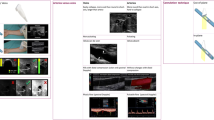Abstract
Purpose
We developed a novel “skin-traction method” in which the puncture point of the skin over the internal jugular vein (IJV) is stretched upward with several pieces of surgical tape in the cephalad and caudad directions to facilitate cannulation of the IJV. We investigated whether this method increases the cross-sectional area of the IJV.
Methods
In 11 healthy volunteers, the cross-sectional area, anteroposterior diameter, and transverse diameter of the right IJV (RIJV) were recorded by ultrasound echo at head tilts of +10°, +5°, 0°, −5°, and −10° with and without the skin-traction method.
Results
The skin-traction method significantly increased the cross-sectional areas of the RIJV at head tilts of +10°, +5°, and 0°. In the flat position, the skin-traction method increased the cross-sectional area of the RIJV from 1.21 ± 0.44 cm2 to 1.75 ± 0.60 cm2 (44.6% increase), which is almost the same as that in the Trendelenburg position without this method (1.60 ± 0.54 cm2 at −5° and 1.83 ± 0.56 cm2 at −10°). The anteroposterior diameter of the RIJV was significantly increased in all positions with this method, although the transverse diameter was not.
Conclusion
This method significantly increased the cross-sectional area of the RIJV by increasing the anteroposterior diameter of the RIJV. Even in the flat position, this method was almost as efficacious as the Trendelenburg position. This method thus appears to facilitate IJV cannulation.
Similar content being viewed by others
References
Y Hayashi O Uchida O Takaki Y Ohnishi T Nakajima H Kataoka M Kuro (1992) ArticleTitleInternal jugular vein catheterization in infants undergoing cardiovascular surgery: an analysis of the factors influencing successful catheterization Anesth Analg 74 688–693 Occurrence Handle1567036 Occurrence Handle10.1213/00000539-199205000-00012 Occurrence Handle1:STN:280:DyaK383jtFWntw%3D%3D
AC Gordon JC Saliken D Johns R Owen RR Gray (1998) ArticleTitleUS-guided puncture of the internal jugular vein: complications and anatomic considerations J Vasc Interv Radiol 9 333–338 Occurrence Handle9540919 Occurrence Handle1:STN:280:DyaK1c7pvF2rug%3D%3D Occurrence Handle10.1016/S1051-0443(98)70277-5
G Parry (2004) ArticleTitleTrendelenburg position, head elevation and a midline position optimize right internal jugular vein diameter Can J Anesth 51 379–381 Occurrence Handle15064268 Occurrence Handle10.1007/BF03018243
PJ Armstrong R Sutherland DH Scott (1994) ArticleTitleThe effect of position and different maneuvers on internal jugular vein diameter size Acta Anaesthesiol Scand 38 229–231 Occurrence Handle8023661 Occurrence Handle1:STN:280:DyaK2c3psFeksA%3D%3D
DL Mallory T Shawker G Evans W Mcgee M Brenner M Parker G Morrison P Mohler C Veremakis JE Parrillo (1990) ArticleTitleEffects of clinical maneuvers on sonographically determined internal jugular vein size during venous cannulation Crit Care Med 18 1269–1273 Occurrence Handle2225897 Occurrence Handle10.1097/00003246-199011000-00017 Occurrence Handle1:STN:280:DyaK3M%2FjtVKntQ%3D%3D
CA Sulek N Gravenstein RH Blackshear L Weiss (1996) ArticleTitleHead rotation during internal jugular vein cannulation and risk of carotid artery puncture Anesth Analg 82 125–128 Occurrence Handle8712386 Occurrence Handle10.1097/00000539-199601000-00022 Occurrence Handle1:STN:280:DyaK287isVyjtA%3D%3D
S Nakayama M Yamashita Y Osaka T Isobe H Izumi (2001) ArticleTitleRight internal jugular vein venography in infants and children Anesth Analg 93 331–334 Occurrence Handle11473854 Occurrence Handle10.1097/00000539-200108000-00018 Occurrence Handle1:STN:280:DC%2BD3MvislSmtQ%3D%3D
ImageJ. Image processing and analysis in Java. http://rsb.info.nih.gov/ij/
P Asheim U Mostad P Aadahl (2002) ArticleTitleUltrasound-guided central venous cannulation in infants and children Acta Anaesthesiol Scand 46 390–392 Occurrence Handle11952438 Occurrence Handle10.1034/j.1399-6576.2002.460410.x Occurrence Handle1:STN:280:DC%2BD383hs1CmsA%3D%3D
Author information
Authors and Affiliations
About this article
Cite this article
Morita, M., Sasano, H., Azami, T. et al. The skin-traction method increases the cross-sectional area of the internal jugular vein by increasing its anteroposterior diameter. J Anesth 21, 467–471 (2007). https://doi.org/10.1007/s00540-007-0562-6
Received:
Accepted:
Published:
Issue Date:
DOI: https://doi.org/10.1007/s00540-007-0562-6




